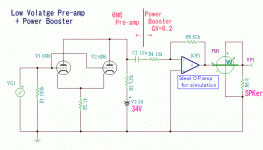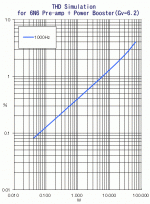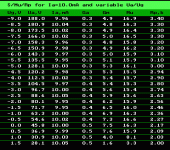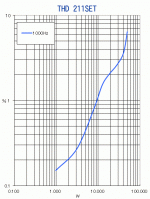Hello from Japan !
Based on my experiences, one of the reasons of tube sounds comes
from 2nd order distortion as is far different from solid state amps.
In the sense, I did a circuit simulation of low supply voltage
pre-amp as follows:
Supply Plate Voltage = 34V
(consists of 19V + 15V by Laptop PC Power Supplies)
Used tube = 6N6P, Russian Low rp tube to work under low voltage
Voltage Gain of Pre-amp = 2.6 (approx.)
In order to consist power amp, I added a power booster for
simulation purpose whose spec is as follows:
*Simulator = TINA-TI version 9
*power amp = Ideal OP amp
*GV = 6.2
* Simulation circuit schematic and result are shown in the attached photos.
As the simulation result, THD= 0.4% @1W and 1.3% @10W which are
near same as 211 SET.
For the actual amp, I am going to use Class-D amp as the power
booster.
Based on my experiences, one of the reasons of tube sounds comes
from 2nd order distortion as is far different from solid state amps.
In the sense, I did a circuit simulation of low supply voltage
pre-amp as follows:
Supply Plate Voltage = 34V
(consists of 19V + 15V by Laptop PC Power Supplies)
Used tube = 6N6P, Russian Low rp tube to work under low voltage
Voltage Gain of Pre-amp = 2.6 (approx.)
In order to consist power amp, I added a power booster for
simulation purpose whose spec is as follows:
*Simulator = TINA-TI version 9
*power amp = Ideal OP amp
*GV = 6.2
* Simulation circuit schematic and result are shown in the attached photos.
As the simulation result, THD= 0.4% @1W and 1.3% @10W which are
near same as 211 SET.
For the actual amp, I am going to use Class-D amp as the power
booster.
Attachments
Many of us here design low level tube electronics that is extremely linear and has similarly good noise and distortion performance to well designed solid state gear. I'm not particularly interested in any circuit for use in hi-fi that is deliberately intended to color the sound by adding second harmonic as a "sweetener" i.e. a sound effects generator - I suspect many here would agree.
Many tube types are inherently more linear than their semiconductor counterparts in zero and low feedback configurations and that is why I use them.
Many tube types are inherently more linear than their semiconductor counterparts in zero and low feedback configurations and that is why I use them.
How do you draw the load line on datasheet IV curve with such a low B+? Do you generate your own low voltage IV curve?
http://www.lampizator.eu/UPGRADE/RU-6N6P.pdf
http://www.lampizator.eu/UPGRADE/RU-6N6P.pdf
How do you draw the load line on datasheet IV curve with such a low B+? Do you generate your own low voltage IV curve?
http://www.lampizator.eu/UPGRADE/RU-6N6P.pdf
I found an actual measured IV values at a Russian Web site (I forgot the URL).
Those measued values are shown in the attached photo.
I generated a SPICE model for TINA-TI based on the measured values
as follows.
* Generic triode model: 6N6
* Copyright 2003--2008 by Ayumi Nakabayashi, All rights reserved.
* Version 3.10, Generated on Sun Nov 22 23:27:49 2009
* Plate
* | Grid
* | | Cathode
* | | |
.SUBCKT 6N6 A G K
.PARAM X1=0.28728514 X2=0.023818988 X3=-0.69616265
.PARAM X4=0.68300952 X5=13.30831 X6=2.1961627
.PARAM X7=0.0027779074 X8=19.484809 X9=0.0016279111
.PARAM Y1=0.0013889537 Y2=0.0016055263
BK IK 0 V=U(V(G,K)+X1)*X7*URAMP(V(G,K)+X1+URAMP(V(A,K))/X8)^1.5+(1-U(V(G,K)+X1))*X9*(X2*URAMP(V(A,K)))^X3*(X4*URAMP(V(G,K)+X1+URAMP(V(A,K))/X5))^X6
BA A K I=URAMP((Y2*URAMP(V(A,K))^1.5)-URAMP((Y2*URAMP(V(A,K))^1.5)-V(IK)+Y1*URAMP(V(G,K))^1.5*(URAMP(V(G,K))/(URAMP(V(A,K))+URAMP(V(G,K)))*1.2+.4)))+1E-10*V(A,K)
BG G K I=Y1*URAMP(V(G,K))^1.5*(URAMP(V(G,K))/(URAMP(V(A,K))+URAMP(V(G,K)))*1.2+.4)
* CAPS
CGA G A 3.5p
CGK G K 4.4p
CAK A K 1.7p
.ENDS
*
Attachments
Many tube types are inherently more linear than their semiconductor counterparts in zero and low feedback configurations and that is why I use them.
I like the sonic of my 211SET whose distortion charachteristics (NFB=3dB)
are shown in the attched photo. THD = 1% at 10W, 2 % at 20W.
Those THD's are alomost identical to 6N6 pre-amp+Booster (my original post).
My 211SET uses 1050V plate supply voltage but 6N6 pre-amp uses only 34V.
Attachments
Hello, Japan!
Just an observation, but shouldn't the whole point of a high quality audio preamp be extremely low distortion?
Given you can't hear distortion below about .5% (at least at frequencies above 8 kHz) and any decent tube preamp will likely be an order of magnitude lower in distortion than that, how could you hear it?
That seems to blow the harmonic distortion theory.
However, I have another theory and that is related to a tube power amplifier and the impedance of the speaker it is driving rather than a preamp.
Tube power amps tend to produce more power with a higher impedance load, while transistor amps are the reverse. Since the typical speaker impedance is high at its lower resonance peak, then drops to its lowest in the midrange, then slowly rises in the high frequency range, it would seem that a tube amp will produce a little more bass and a little more sparkle in the treble region compared to a solid state amp, which produces lower power at these same frequencies.
This would indicate that the preamp may not really contribute anything to the tube sound after all. It also says that it isn't distortion as well because the distortion components (if the amp is operated within its design limits) should be below the threshold of detection.
The debate that a tube preamp versus a solid state preamp produces different sound may be simply listener bias if both preamps have the same specifications.
Nevertheless, my preamp and power amp are both tubes and I am happy with the sound I get from them and regardless of the technical performance specs it is my happiness that is important to me.
Just an observation, but shouldn't the whole point of a high quality audio preamp be extremely low distortion?
Given you can't hear distortion below about .5% (at least at frequencies above 8 kHz) and any decent tube preamp will likely be an order of magnitude lower in distortion than that, how could you hear it?
That seems to blow the harmonic distortion theory.
However, I have another theory and that is related to a tube power amplifier and the impedance of the speaker it is driving rather than a preamp.
Tube power amps tend to produce more power with a higher impedance load, while transistor amps are the reverse. Since the typical speaker impedance is high at its lower resonance peak, then drops to its lowest in the midrange, then slowly rises in the high frequency range, it would seem that a tube amp will produce a little more bass and a little more sparkle in the treble region compared to a solid state amp, which produces lower power at these same frequencies.
This would indicate that the preamp may not really contribute anything to the tube sound after all. It also says that it isn't distortion as well because the distortion components (if the amp is operated within its design limits) should be below the threshold of detection.
The debate that a tube preamp versus a solid state preamp produces different sound may be simply listener bias if both preamps have the same specifications.
Nevertheless, my preamp and power amp are both tubes and I am happy with the sound I get from them and regardless of the technical performance specs it is my happiness that is important to me.
Hello from Japan !
Based on my experiences, one of the reasons of tube sounds comes
from 2nd order distortion as is far different from solid state amps.
In the sense, I did a circuit simulation of low supply voltage
pre-amp as follows:
Supply Plate Voltage = 34V
(consists of 19V + 15V by Laptop PC Power Supplies)
Used tube = 6N6P, Russian Low rp tube to work under low voltage
Voltage Gain of Pre-amp = 2.6 (approx.)
In order to consist power amp, I added a power booster for
simulation purpose whose spec is as follows:
*Simulator = TINA-TI version 9
*power amp = Ideal OP amp
*GV = 6.2
* Simulation circuit schematic and result are shown in the attached photos.
As the simulation result, THD= 0.4% @1W and 1.3% @10W which are
near same as 211 SET.
For the actual amp, I am going to use Class-D amp as the power
booster.
No, it's the opposite. What the listeners commonly characterize as "tube" sound is the dominance of second order harmonics followed by much weaker third order harmonics and then diminishing harmonics beyond those. It's the typical traits of SE design.THD does not make the characteristic of a tube amplifier. When looking at distortion only, it's important to maintain the relation of higher uneven order harmonics with lower even harmonics.
The other "tube" sound that listeners describe is the high frequency roll-off of some tube amps. You can make class AB transistor amp to sound like this by using equalizer.
No, it's the opposite. What the listeners commonly characterize as "tube" sound is the dominance of second order harmonics followed by much weaker third order harmonics and then diminishing harmonics beyond those. It's the typical traits of SE design.
The other "tube" sound that listeners describe is the high frequency roll-off of some tube amps. You can make class AB transistor amp to sound like this by using equalizer.
I understand now. I was considering a push-pull amp and those distortion components should be inaudible if the amp is working correctly.
SE amps produce much more distortion which is audible, which I guess is the "tube sound".
SE amps produce much more distortion which is audible, which I guess is the "tube sound".
Sorry, there's no tube sound. Tubes only produce sound under bad conditions like dropping on the floor, disconnecting a loudspeaker or using outside their optimal operation area (for effects or musical instrument amplifiers). To some this statement is outside their comfort zone it seems
No, it's the opposite. What the listeners commonly characterize as "tube" sound is the dominance of second order harmonics followed by much weaker third order harmonics and then diminishing harmonics beyond those. It's the typical traits of SE design.
I agree with you based on my experiences and Pete Millett's article
as follows:
the Sound of Distortion
I like the sonic of my 211SET.
How did you find that out?No, you're wrong. Second harmonics up to 1% are not noticeable by ear.
Strong even harmonic (second order) masks odd harmonics that follow which is the typical traits of SE amp. That's what people notice when listening to SE amp and PP amp at equal volume.Half that value in 5H or 7H is, that's why most listeners to quality gear appreciate good tube amps over good SS amps.
Here are the measurements of 3 different amps at same output under 8 Ohm load. 2 are PP design and 1 is SE. Second harmonic from SE amp is about twice as high as third harmonic that follows. The other 2 amps don't have the benefit of even harmonic masking.
An externally hosted image should be here but it was not working when we last tested it.
Sorry, there's no tube sound. Tubes only produce sound under bad conditions like dropping on the floor, disconnecting a loudspeaker or using outside their optimal operation area (for effects or musical instrument amplifiers). To some this statement is outside their comfort zone it seems
I'm not sure how the two contrasting posts can be made by one person.Half that value in 5H or 7H is, that's why most listeners to quality gear appreciate good tube amps over good SS amps.

Member
Joined 2009
Paid Member
I've engineered 2nd harmonics into solid state amps before - they didn't sound like tube amplifiers though and only one of them sounded nice, when not pushed too hard. I have a single ended tube amp to compare them with.
I suspect that if you want tube sound, you need a tube amp. Putting a pre-amp in place for tube sound might work if the SS amp is so clean it just gets out of the way, but tube amps are also about how they interact with the reactive load of a speaker.
I came to the conclusion that putting a tube in front of a SS amp hoping for that old tube sound is like putting a Weber carb on a Ferrari engine hoping it would drive and sound like a 1964 Mustang.
I suspect that if you want tube sound, you need a tube amp. Putting a pre-amp in place for tube sound might work if the SS amp is so clean it just gets out of the way, but tube amps are also about how they interact with the reactive load of a speaker.
I came to the conclusion that putting a tube in front of a SS amp hoping for that old tube sound is like putting a Weber carb on a Ferrari engine hoping it would drive and sound like a 1964 Mustang.
I'm not sure how the two contrasting posts can be made by one person.
Have a test to distinguish a 1% 2KHz sinus (that's -40dB) from a 1KHz sinus. Hold that level and turn up the frequency. What's your conclusion?
There's simply more to a tube amplifier than THD only, that's my point.
Please don't play word games, you're better than that. I won't place my words on a scale before posting, it's robbing the fun from a forum.

You quoted my post pointing out your contradiction of your own post and your reply is about playing sine wave?Have a test to distinguish a 1% 2KHz sinus (that's -40dB) from a 1KHz sinus. Hold that level and turn up the frequency. What's your conclusion?
"there's no tube sound."
"that's why most listeners to quality gear appreciate good tube amps over good SS amps"
Did those listeners listen to music instead?
I don't remember saying there isn't. Anyway, can you name some of them?There's simply more to a tube amplifier than THD only, that's my point.
I've already explained to you on the importance of wording on internet forums (link) and yet those words seem to have hit the brick wall!Please don't play word games, you're better than that.
To you, it's ok to post misleading info online as long as you are having your own fun?I won't place my words on a scale before posting, it's robbing the fun from a forum.
I've engineered 2nd harmonics into solid state amps before - they didn't sound like tube amplifiers though and only one of them sounded nice, when not pushed too hard. I have a single ended tube amp to compare them with.
I suspect that if you want tube sound, you need a tube amp. Putting a pre-amp in place for tube sound might work if the SS amp is so clean it just gets out of the way, but tube amps are also about how they interact with the reactive load of a speaker.
I came to the conclusion that putting a tube in front of a SS amp hoping for that old tube sound is like putting a Weber carb on a Ferrari engine hoping it would drive and sound like a 1964 Mustang.
I think you nailed it. It is all about driving the reactive load and the difference between a current drive amplifier (tube) and a voltage drive amplifier (solid state).
A tube preamp driving a solid state amp will not inject magic into the system. Any sound difference noticed will have to do with the quality differences between the two preamps.
I think the analogy you actually meant was putting Weber carburetors on a 1964 Mustang and thinking it will perform like a Ferrari 308.
- Status
- This old topic is closed. If you want to reopen this topic, contact a moderator using the "Report Post" button.
- Home
- Amplifiers
- Tubes / Valves
- Pre-amp for Tube Sound



